Last Saturday I was able to bird the “middle” portion of the Carpinteria salt marsh (normally inaccessible to outside visitors). Even better, I got to go in with Peter Gaede and Andrea Adams-Morden, two of my favorite people when I want to learn more about birds or plants (respectively). That’s damning with faint praise, though, in that Peter and Andrea are just fun to be with. They’re interested in everything going on in the natural world, always noticing things and always happy to share what they’ve noticed.
We entered on Estero Way, and worked our way out to the mouth of the marsh. Then we retraced our steps, and wrapped around next to the railroad tracks until we could walk out along the dike on the west side of the Santa Monica Creek channel. Toward the southern end of the dike there is a large patch of an invasive non-native with tall spindly stalks; Andrea tentatively ID’d it as black mustard (Brassica nigra). Here’s a shot looking past one of those stalks back toward the northwest:
I took that photo because Andrea had notice something interesting in the plant. Here’s a closer view:
It’s a collection of six spherical objects suspended in a loose web; Andrea’s guess was that they were spider egg sacs. Here’s a close-up:
There was one more interesting thing we noticed: Where the stem holding the spheres met the main stalk of the plant, there was a triangular structure that appeared to be made from the same silk as the web. You can see it on the left side of this picture:
Here’s a close-up:
We couldn’t find any spider to go with the putative egg cases, but after I got home I posted photos on bugguide.net, and within 15 minutes Charley Eiseman, co-author of the upcoming book Tracks & Sign of Insects & Other Invertebrates (which I can’t wait to buy) had ID’d the spheres for me. They are indeed the egg cases of a spider, specifically the Bolas spider Mastophora cornigera.
The spider is nocturnal; it hides in plain site during the day by looking exactly like a rounded bird dropping. (When I mentioned that to Andrea, she replied that she actually had noticed what she thought was a bird dropping on the plant not far from the egg sacs. I didn’t notice it at the time, and I can’t find it in any of my photos, unfortunately.)
The spider also has an interesting way of hunting: It dangles a strand of silk with a sticky ball on the end, and swings it with one of its legs to capture flying insects. The ball gives off a scent that mimics moth pheromones, and researchers have found that the spider can vary the scent over the course of an evening to appeal to different moth species that are active at different times of night.
Here’s a segment from David Attenborough’s Life in the Undergrowth showing M. cornigera hunting:
One mystery I still haven’t solved: What was that triangular silk structure at the base of the stem? I tried sending an email to Peter Bryant, a biologist at UC Irvine who has posted some neat photos of Bolas spiders on the web. I wrote him as follows:
I came across what I believe are some Mastophora cornigera egg cases yesterday at the Carpinteria Salt Marsh. I’m curious about one thing, though: There was an odd triangular structure, apparently built out of spider silk, at the point where the stem from which the egg sacs are suspended meets the main stalk of the plant. You can view a photo of the structure in relation to the egg sacs here:
https://bugguide.net/node/view/356752/bgimage
…and a closeup of the triangular structure here:
https://bugguide.net/node/view/356754/bgimage
At first I was thinking the structure might be a hiding place for the spider, but now that I’ve had some help identifying the species, and have looked at the wonderful photos you’ve posted of the adult female, I don’t think that structure would be large enough to hide one (and it doesn’t sound like they go in for that sort of thing, anyway, given their impressive bird-dropping mimicry).
I’m trying to figure out what purpose that structure might have. My lay speculation so far consists of:
* The aforementioned hiding place for the adult spider.
* A structural reinforcement, to prevent the weight of the egg sacs from causing the stem to break off the plant.
* A barrier to help prevent egg-sac predators from traveling from the stalk to the stem.I’m curious if you know the answer, or would be willing to speculate. Thanks!
Dr. Bryant wrote me back, but unfortunately he didn’t have any ideas about that triangular silk structure. He suggested visiting the location again to see if the spider is nearby, which I’d love to do, but so far I haven’t had a chance (and I’d need to go with Peter, or someone else with official permission to enter that part of the marsh).
More Bolas spider links:
- Wikipedia article on Bolas spiders
- Bolas spider, Mastrophora cornigera - Interesting photos and captions by Peter J. Bryant.
- Science Spider Friday: The Bolas Spider! - by DailyKos user hekebolos
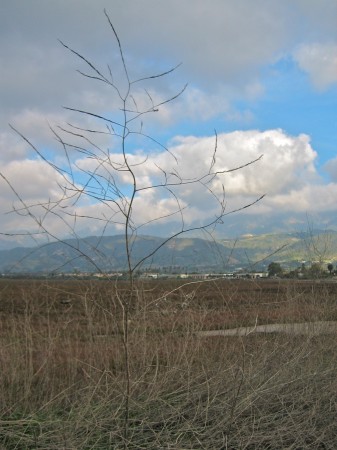
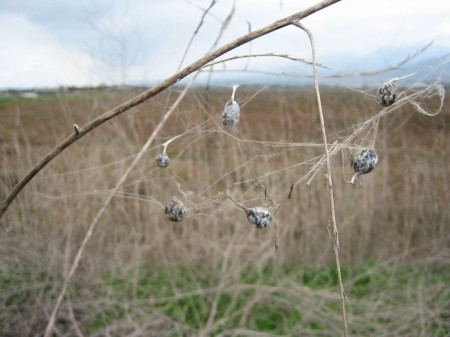
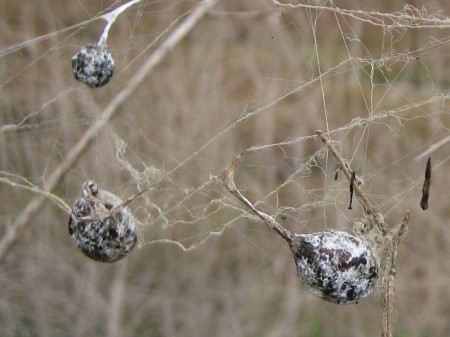
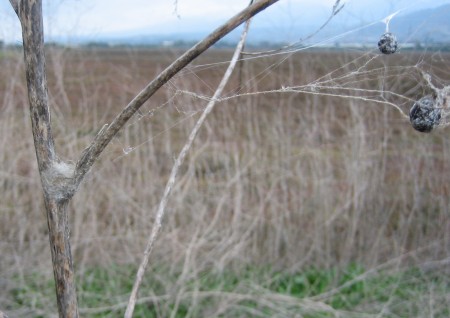
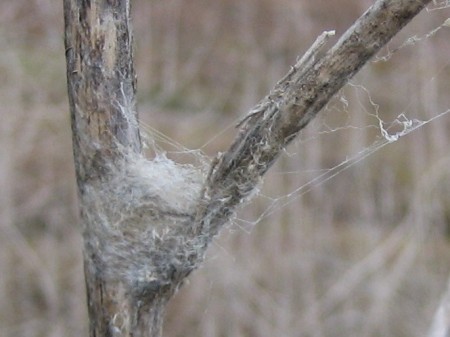
Hey! I know I am a bit late since this was posted about 2 years ago, but I have been searching for some bolas spiders. Would you know how I could get my hands on a few?
I’m afraid I don’t know where to find them, no, other than to say that I found that one example at the Carpinteria Salt Marsh, and later another docent (Andrea Adams-Morden) told me she’d found another set of bolas spider egg cases in another part of the same marsh. So they’re at least sometimes found in the weedy/sage scrub borders of one southern California coastal salt marsh.
I have six egg sacs at my house in north Torrance, CA, near Los Angeles.